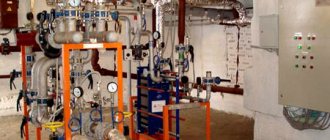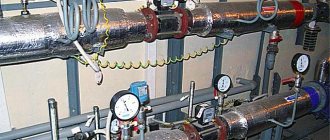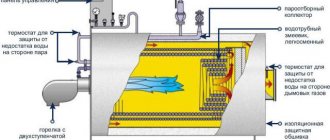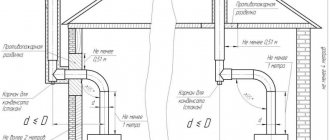Home / Heating
Back
Published: 02/02/2021
Reading time: 3 min
0
1601
To switch to individual heating in an apartment building, you need to abandon the existing mains, radiators and pipes, which are provided for use by the housing and communal services. There are two popular types of equipment, a gas or an electric boiler, but before installing the unit, several important issues must be resolved.
I would like to consider generally accepted rules and regulations, without compliance with which you can get into a lot of problems and disrupt your relationship with regional authorities. It is worth highlighting the advantages and disadvantages, I will provide a list of documents for autonomous heating and tell you what equipment can help create the most comfortable environment in the apartment.
- 1 Rules and regulations by law
- 2 Advantages and disadvantages of individual apartment heating
- 3 Documents for switching to individual heating 3.1 Coordination and obtaining permission
- 3.2 Project development
- 4.1 Gas boiler
Rules and regulations by law
All nuances are clearly regulated; to familiarize yourself with the information in detail, before starting to implement your plan, you should take a look at Article 26 of the Housing Code.
In this document you will find a list of necessary papers and learn the main aspects regarding the transition to autonomous heating. In 2022, an equally important decree, Federal Law No. 190, was changed, namely, Article 14 covers such points as:
- Conclusion of a contract and the possibility of connecting to the existing infrastructure for the implementation of heat supply.
- Situations are considered in which it is not possible to abandon the central heating center.
- Standards and algorithm of actions for the installation of all communications that are necessary for autonomous heating.
You should also look at decree number 1314 if the equipment will be powered by blue fuel. The document is able to clarify the following:
- Is it possible to connect to the main line of the building in which the apartment is located and how does this happen?
- Details of the procedure.
- Basic requirements for the project and its preparation.
Clause 7.3.7 of SNiP numbered 31-01-2003 provides important nuances that relate to the transition to individual supply. If you carefully study the papers, it becomes clear that such changes can be made in new buildings where such an opportunity was provided.
You can refuse central heating only when installing units with a closed chamber. The design documentation is taken into account, in which you can find information on the following points:
- General information about heating an apartment building.
- Gas supply input diagram, information about the devices.
- Ventilation and house communications, pipes for removing combustion products.
- The area of the room where the boiler is installed should not be less than 15 square meters. m.
It is worth considering the point that it will be possible to completely disconnect the central heating riser from the house with the consent of all residents, without exception. Selective or partial disconnection is prohibited, since the communications will not function properly and the radiators in some apartments will become warm, which is not enough to properly heat the home.
Engineering systems are the basis of the “life” of any apartment building (MCD). The degree of improvement of the house and the comfort of living in it depend on their presence and condition.
(Slide 2) In accordance with the Rules for the maintenance of common property, approved by Decree of the Government of the Russian Federation of August 13, 2006 No. 491 (hereinafter referred to as Rules No. 491), utility networks are included in the common property of the owners of premises in apartment buildings.
In accordance with the provisions of the classification, the following gradation of the main engineering systems of MKD has been determined:
- heating system, including boiler installation for heating (if the latter is located in the building itself);
- internal water supply, gas and sewerage networks with all devices;
- internal network of power and lighting electrical wiring with all lighting fixtures;
- internal telephone and signaling networks;
- ventilation devices for general sanitary purposes;
- lifts and elevators.
Each of them is responsible for transferring a specific resource. Based on the types of resources transferred, they can be divided into:
- mechanical;
- electrical;
- sanitary and technical.
The utility provider (management company, HOA or housing cooperative) is responsible for the maintenance of the common property in the house, including utilities located inside the house and intended for its maintenance under the MKD management agreement, and in the case of direct management of the house, the owners of the premises in the house ( clauses 5-7 of Rules No. 491).
The external boundary of the networks that are part of the common property is the external boundary of the wall of the apartment building, and the boundary of operational responsibility in the presence of a common house metering device (GMU) of the corresponding utility resource is the place where the meter connects to the corresponding engineering network of the apartment building. An agreement between the owners of the premises and the utility provider or resource supplying organization may establish a different limit of operational responsibility.
Is it possible to transfer some premises to an apartment building?
for individual heating?
(Slide 3) The system of relationships in heat supply is regulated by Federal Law No. 190 of July 27, 2010 “On Heat Supply,” which is aimed at ensuring a sustainable and reliable supply of heat energy to consumers.
It is prohibited by law to unauthorizedly dismantle or turn off the heating systems provided for in the design and (or) technical documentation for an apartment building or residential building (clause “c”, paragraph 35 of the “Rules for the provision of utility services to owners and users of premises in apartment buildings and residential buildings”, approved by Decree of the Government of the Russian Federation dated May 6, 2011 No. 354).
(Slide 4) The municipality approves a heat supply scheme, which, as a rule, provides a List of houses where switching to individual heating is possible. Accordingly, all residents of houses not included in the list will be denied reconstruction.
If the transition to individual heating of apartment buildings is not provided for in the heat supply scheme, then it will be necessary to update the scheme (provisions of the Decree of the Government of the Russian Federation of February 22, 2012 No. 154), including in terms of determining the list of measures for the reconstruction and modernization of the boiler house that heats the corresponding house, after changing the connected heat load, with identification of investment sources.
Whether this is possible or not is up to local governments to decide. It is to the municipal administration that the owners must apply to disconnect the apartment building from the centralized heating system and switch to heat supply using individual sources of thermal energy, as well as with a proposal to make appropriate changes to the heat supply scheme of the city or village.
The municipal heat supply scheme is updated annually and is reported through the media. Local authorities are required to place a notice of updating no later than January 15 of the year preceding the year for which the scheme is updated.
(Slide 5) Equipping residential premises of an apartment building with individual heating sources is a reconstruction of residential premises and entails the installation, replacement and transfer of utility networks and requires amendments to the technical passport of the residential premises (Part 1 of Article 25 of the Housing Code of the Russian Federation).
To obtain such approval from the local government body, the owner of the premises being converted must provide:
- an application for reconstruction in the prescribed form (only the owner of the relevant premises or someone authorized by him can take such an initiative);
- title documents for the residential premises being converted into an apartment building;
- a project for the reconstruction of residential premises in an apartment building, prepared and executed in accordance with the established procedure, as well as a protocol of the general meeting of premises owners on the consent of all owners of the premises of the house for such reconstruction (Part 2 of Article 40 of the Housing Code of the Russian Federation);
- technical passport of the converted premises in the apartment building;
- consent in writing of all family members of the owner of the premises being renovated.
At the same time, the development of the project should be carried out on the basis of the technical conditions for connecting a capital construction project to engineering support networks and the rules for connecting a capital construction project to engineering support networks (Resolution of the Government of the Russian Federation dated February 13, 2006 No. 83)
It should be noted that re-equipment and redevelopment of residential premises, leading to a violation of the strength and destruction of the load-bearing structures of the building, disruption of the operation of engineering systems of equipment installed on it, deterioration of the safety and appearance of facades, violation of fire safety devices, is not allowed (clause 1.7.2 of the resolution State Committee of the Russian Federation for Construction and Housing and Communal Sector dated September 27, 2003 No. 170).
In addition, the engineering support system is one of the systems of a building or structure, designed to perform the functions of water supply, sewerage, heating, ventilation, etc., the parameters and other characteristics of the engineering support systems during operation and construction must comply with the requirements design documentation (Federal Law No. 384 of December 30, 2009 “Technical Regulations on the Safety of Buildings and Structures”).
From the analysis of the above standards, it follows that the project for the reconstruction of residential premises with individual heating sources must comply with building codes and design rules and be agreed upon with the heat supply organization, since it affects the general building engineering heating system.
Taking into account the fact that the heating system of an apartment building is a single system consisting of risers, heating elements, control and shut-off valves, collective (common house) heat energy metering devices and other equipment located on these networks, in order to disconnect from the centralized heating system, an additional requirement must be a project for the reconstruction of the MKD system should be developed.
A project must also be developed for the reconstruction of the gas supply (electricity) system of the apartment building, if it is planned to use gas (electric) heating as a source of individual heating.
| Note! For the reconstruction of premises, which entails a reduction in the size of the common property in the apartment building, including in-house utility networks, the consent of 100% of the owners of the premises in the apartment building is required. |
(you can go back to slide 3)
The Ministry of Construction of Russia adds: the procedure for switching to heating residential premises in apartment buildings using individual apartment sources of thermal energy is quite complex and expensive. It is more expedient to carry out the transition not of an individual residential premises, but of the house as a whole (Letter dated October 15, 2014 N 22588-OD/04). And the Supreme Court, in its Decision dated 05/07/2015 No. AKPI15-198, left unchanged by the Appeal Ruling of the RF Armed Forces dated 08/27/2015 N APL15-330, indicated that the ban on the transition to the use of individual apartment sources of heat energy was established in order to maintain the heat balance of the entire residential building, since when switching to individual heat supply for at least one apartment in an apartment building, the temperature in the adjacent rooms decreases, the hydraulic regime in the intra-house heating system is disrupted, gas consumption significantly increases, for which the building’s engineering systems are not designed, and the explosion and fire hazard increases.
.
How is payment for heat in houses calculated?
with a mixed heating system?
(Slide 6) Until 2022, for houses connected to a centralized heating system, in which one or more apartments switched to an individual heat source, there was no separate procedure for calculating fees, so resource supply companies were forced to charge residents of such apartments payments for gas, and for central heating in full. The total consumption of thermal energy by apartment buildings inevitably fell on the owners of residential premises connected to a centralized heating system, which led to an unreasonable increase in heating fees and dissatisfaction on the part of such consumers. The problem has been brewing for years.
On December 28, 2022, the Government of the Russian Federation approved the procedure for such houses (Resolution of the Government of the Russian Federation dated December 28, 2022 No. 1708).
From January 1, 2022, residents of apartments who switched to individual heating in a building connected to a centralized system must pay only for thermal energy spent on maintaining common property in the apartment building. In this case, the payment for “general” heat will be calculated according to a special formula. The total area of the house, the area of the apartment with individual heating, the area of common areas, the share in the total property of the apartment building and other parameters will be taken into account.
Indoor gas equipment
(Slide 7) In-house gas equipment (VDGO) is common property in the apartment building, which includes:
- gas pipelines of an apartment building or a private house connected to the gas distribution network;
- gas risers in the house;
- shut-off valves located on branches to individual gas equipment;
- common house metering devices;
- gas-using equipment;
- indoor gas control systems;
- technical devices (control valves, etc.).
In recent years, natural gas explosions have regularly occurred due to improper operation of the VDGO. Most often, various incidents and accidents occur in places of direct contact between gas distribution networks and gas consumers, i.e. in places where intra-house gas networks are laid and installation of intra-house gas equipment (gas stoves, gas water heaters). The number of accidents caused by unsatisfactory technical condition and maintenance of in-house gas equipment is also growing.
Prerequisites for accidents on VDGO networks:
- careless handling of gas equipment;
- unauthorized connection;
- unauthorized reconstruction of VDGO;
- redevelopment of premises without approval;
- improper maintenance of chimneys and ventilation ducts;
- use of faulty gas equipment;
- outdated indoor gas networks.
Natural gas explosions are accompanied by severe consequences: human casualties, complete destruction of property and entire sections of residential buildings.
VDGO service contract
(Slide Responsibility for the condition and safety of VDGO lies with citizens. According to the order of the Ministry of Regional Development dated June 26, 2009 No. 239 and the Decree of the Government of the Russian Federation dated July 21, 2008 No. 549, citizens are required to enter into agreements for the maintenance and repair of VDGO with specialized organizations. On behalf of citizens must be a management company/homeowners association/housing cooperative or other organization.
Responsibility for the condition and safety of VDGO lies with citizens. According to the order of the Ministry of Regional Development dated June 26, 2009 No. 239 and the Decree of the Government of the Russian Federation dated July 21, 2008 No. 549, citizens are required to enter into agreements for the maintenance and repair of VDGO with specialized organizations. On behalf of citizens must be a management company/homeowners association/housing cooperative or other organization.
A specialized company engaged in servicing VDGO is obliged to:
- have your own emergency dispatch service or an agreement on emergency dispatch support with a gas distribution organization;
- have certified specialists.
Individual gas equipment (VKGO) located in the apartments of premises owners is also subject to maintenance. VKGO includes:
- gas stove;
- gas water heater;
- boiler;
- gas meters;
- shut-off valves (gas valve) in front of gas equipment.
Responsibility for the condition and safety of VKGO lies with the owner of the residential premises (Article 210 of the Civil Code of the Russian Federation, Article 30.67 of the Housing Code of the Russian Federation). Maintenance of VKGO is carried out by specialized organizations on the basis of:
- a collective agreement concluded between the contractor company and the organization managing the apartment building, to which such rights have been delegated by the general meeting of owners;
- individual contracts between owners and specialized companies
Concluding a service agreement is the responsibility of the owner, since without it no maintenance is carried out, which can lead to accidents, leaks, household gas explosions and other disastrous consequences.
The supply of gas to faulty gas equipment is unacceptable, therefore, in the absence of an agreement or the owner’s evasion from concluding such an agreement, gas supply to an apartment or non-residential premises is not carried out even in cases where the subscriber regularly pays for the consumed “blue fuel”.
Timing and frequency of scheduled inspections
(Slide 9) In September 2022, changes were made to the Rules for the use of gas in terms of ensuring safety during the use and maintenance of VDGO and VKGO (by Decree of the Government of the Russian Federation No. 410 of May 14, 2013). Based on these changes, maintenance of VDGO and VKGO must be carried out at least once a year, taking into account the minimum list of work performed (services provided).
Maintenance of VKGO is carried out on a paid basis.
Based on the results of checking the gas equipment, the specialist draws up an inspection report, which must contain:
- date and location;
- subscriber information;
- positions and names of the compilers;
- assessment of the technical condition of gas equipment;
- detected defects;
- recommendations to the consumer on the further use of gas equipment.
The act is drawn up in two copies, one is given to the consumer, the second remains with the gas supply organization.
In the event of a malfunction of gas equipment, the drawn up act is the basis for prohibiting the operation of the device and limiting the subscriber’s access to gas supply.
After verification, the user is given a report that contains a list of work performed and recommendations for consumers.
Rules for the safe use of gas at home
If you smell gas in an apartment or household:
- immediately turn off all taps to gas appliances;
- open the windows to ventilate the rooms;
- do not light a fire, do not smoke, do not turn it on or off
- electric lighting and electrical appliances;
- leave the gas-polluted room and call the emergency gas service by phone 04 (from mobile 104, 112).
If you smell gas on the street, in the entrance (basement):
- go out yourself and remove people from the gas leak area (at least 5 m);
- call the gas service dispatcher by phone 04 (from mobile 104, 112);
- provide the exact address where the gas leak occurs, your first and last name;
- do not allow unauthorized people and vehicles into the leakage area;
- wait for the ADF brigade to arrive.
If you have a gas stove in your kitchen:
- Do not repair malfunctions in the stove without permission, turn off the gas and call a gas service technician;
- if you smell gas, close all gas taps, ventilate the premises, do not light a fire, do not turn electrical appliances on or off, call the emergency team by phone 04 (from mobile 104, 112);
- Follow the rules for igniting burners. While the stove is operating, monitor the kitchen ventilation: open the windows slightly, do not close the ventilation duct grilles;
- ventilate the oven before lighting the burners;
- Do not leave lit burners unattended. If the flame suddenly goes out, immediately close all gas taps and thoroughly ventilate the kitchen;
- do not allow preschool children, elderly people or drunk people to access gas appliances;
- do not tie ropes to gas pipelines, do not dry clothes and hair over the flame of burners;
- do not heat the room using a gas stove;
- close the riser valve in front of the stove after each use of gas.
If you use a gas water heater:
- the room where the gas water heater is installed must have free access to outside air (window, window, door with access to an open balcony) and a ventilation hood near the ceiling;
- It is prohibited to install or repair a gas water heater yourself;
- You cannot use a gas water heater with a faulty automatic safety system;
- if gas equipment malfunctions, call a specialist from the gas distribution organization at your place of residence;
- Carry out regular maintenance of gas equipment.
If you use a gas heating furnace (GOV):
- before igniting the gas stove, be sure to OPEN the valve and then the ash door;
- ventilate the firebox, chimney and room for at least 5 minutes;
- Be sure to check the draft in the chimney. To do this, hold a strip of paper to the inspection hole of the firebox or draft stabilizer. If a strip of paper is pulled towards the firebox, the draft is normal, but if it deviates in the opposite direction from the firebox, there is no draft. If there is no draft, it is prohibited to use the stove. The draft is checked before ignition and 5-7 minutes after turning on the stove burner;
- If the stove is working properly and the draft in the chimney is good, light the pilot light. With the pilot light on, open the main burner tap and light it;
- if the burner goes out, immediately close the tap, ventilate the firebox again for 5 minutes and repeat all operations to ignite the main burner;
- the gas burner should burn in all holes without soot, the flame should be violet-blue;
- regularly check the condition of ventilation and smoke ducts: clear them of snow, ice and foreign objects;
- If you smell gas, immediately stop using the stove and contact the gas service by calling 04 (mobile: 104, 112).
Violation of the rules can result in gas being turned off and a fine.
(Slide 10) If a leak is detected in the gas water heater and there is no draft in the chimney, the VDGO maintenance specialist is authorized to turn off the gas without prior notice. Similar consequences await the subscriber if a lack of air flow is detected in the amount necessary for complete combustion of gas, a malfunction or interference with the operation of devices that allow you to automatically turn off the gas supply, or if a specialist detects an unauthorized connection.
Without prior notification to subscribers, the gas distribution company may suspend gas supply if unauthorized gasification is detected, if the orders of the housing control authorities to eliminate violations of the maintenance of VDGO/VKGO are not fulfilled within the established time frame, as well as if the reconstruction of VDGO/VKGO was carried out in violation of the legislation of the Russian Federation.
Gas, after prior notice, can also be turned off if the subscriber has not allowed specialists into the apartment to carry out VDGO maintenance, has not entered into an agreement for VDGO maintenance, or if the subscriber operates a gas appliance with an expired expiration date, the performance of which has not been checked and not confirmed.
In addition, violation of the rules entails a fine:
- for citizens in the amount of 1-2 thousand rubles,
- officials - 5-20 thousand rubles,
- legal entities – 40-100 thousand rubles.
If the listed actions lead to an accident or a threat to the life and health of people, the fine will be:
- for citizens - 10-30 thousand rubles,
- officials - 50-100 thousand rubles,
- legal – 100-400 thousand rubles.
Repeated offenses entail a fine:
- for citizens in the amount of 2-5 thousand rubles,
- for officials – 10-40 thousand rubles or disqualification for 1-3 years,
- for legal entities – 80-200 thousand rubles or suspension of activities for up to 90 days.
Thank you for your attention!
In the next lesson we will cover the topic:
"Management of municipal solid waste"
Advantages and disadvantages of individual apartment heating
There are quite a lot of positive aspects; owners can afford to turn on the equipment themselves in the off-season, and do not have to wait for the start of the heating season in the fall. When connected to central heating communications, it is impossible to adjust the temperature as accurately as possible; this can only be done using a separate unit.
In the age of modern technology, autonomous heating can be controlled remotely using a tablet or smartphone; for this you just need to install an additional device.
Consumption will decrease significantly, which will be noticeable literally in the first year of using a gas or electric appliance. Some models are capable of organizing a continuous supply of water not only to the heating circuit, but also to the hot water taps; this type of product is known to everyone as a double-circuit boiler.
There are also disadvantages, these nuances should be paid attention to even at the stage of thinking about the question of whether it is worth doing individual heating; the disadvantages of the procedure include:
- Difficulties in paperwork.
- Compliance with all rules that were provided by law.
- Organizing an appropriate ventilation system, which will lead to additional waste of the budget.
- Installation belongs to the category of work of increased complexity; the payment for specialists will be high.
- Safety issues and all responsibility when operating the unit falls on the owner of the apartment.
Some costs will soon pay off, because such organization of the system is much more economical than central heating. DHW leaves much to be desired, because in most buildings the heated water is turned off at 22:30, which is not entirely convenient, but with an autonomous supply such situations can be avoided.
Documents for switching to individual heating
You should not expect an easy solution to the issues, because to implement your plan, redevelopment will be required. The process is quite labor-intensive and can take a long time.
The documentation also cannot be completed in one hour; the whole process will take about 3-5 months; you need to take into account the installation and arrangement of the premises for installing a gas boiler, which will also require a week of time. Taking these nuances into account, experts advise starting to prepare the package of documents in advance.
Coordination and obtaining permission
At the beginning of the journey, you need to decide on the papers, in order to obtain permission, you must provide the regional authorities with the following list of certificates:
- Statement.
- Registration certificate.
- Technical passport for the apartment.
- Project.
- A copy of the document about registered people.
- Consent to reconstruction from all registered residents.
- A decision obtained from an organization responsible for the protection of architectural buildings.
After accepting the application, you need to wait for some time; the authorities will need it to verify all the points. The applicant is provided with a receipt containing a list of papers. The process takes no more than 45 days, after this period the organization must make a decision, the act is issued within 3 working days.
Project development
An equally important stage involves drawing up a document for reconstruction; without these papers it is impossible to implement individual gas heating in an apartment building. A preliminary sketch of the location of all important elements is created, attention is paid to the technical characteristics of the unit and the conditions in the home that are planned to be improved.
To determine the exact location of the equipment, specialists carefully study the apartment plan, and only after these actions make a verdict. Based on the project, all components are installed; following the document is very important, because the productivity and efficiency of the device depends on it.
On a note
The issue of charging for heating in the premises of owners in apartment buildings has received a lot of attention since December 2022, when the Constitutional Court of the Russian Federation, in Resolution No. 46-P dated December 20, 2018, established that consumers with individual sources of thermal energy must pay only for the resource consumed for the purpose of maintaining common property.
However, the same resolution No. 46-P states that this applies only to those owners in whose premises the reconstruction of the heat supply system was carried out with the receipt of all permits. At the same time, all owners of premises in the house pay for the resource consumed to maintain the common property.
The case discussed above precisely implements the requirements voiced by the Constitutional Court of the Russian Federation that without registering the reconstruction in the manner prescribed by law, the owner is obliged to pay for centralized heat supply in full, even when installing autonomous equipment.
Necessary equipment for individual heating of an apartment
If you carefully study the project, you can find information from specialists regarding the devices. It’s worth looking at this first; not all units are maximally suitable for heating.
But you don’t need to fully rely on the opinion of experts; only through personal study of the issue will you be able to choose the ideal option for your apartment.
A gas boiler
To determine the devices prohibited for use to implement your plan, you should look at the resolution number 307, namely paragraph 44. If you study it carefully, you can find a list of devices that should not be purchased for installation in an apartment.
But selection tips will be no less useful, among which you can find the following important points related to a gas boiler:
- The presence of a closed combustion chamber.
- Automated shutdown of blue fuel supply.
- The coolant temperature should not reach above 95 degrees.
- Pressure no more than 1 MPa.
At the personal discretion of the home owner, he selects single-circuit or double-circuit equipment; if you follow all the advice exactly, you can avoid a lot of problems during operation.
Heating using an electric boiler
Units powered from the network are also in great demand; to organize high-quality autonomous supply, you need to correctly calculate the power. There is a fairly simple method to carry out the manipulation; you need to find out the area of the rooms and allocate for every 10 square meters. m 1 kW.
But do not forget that when purchasing a unit for electric heating of an apartment, which has a power of more than 9 kW, you will need to re-equip the existing network; the cable must be selected with the appropriate cross-section. It is possible to heat the premises using the principle of direct heating with electrical appliances, which will also require an individual approach to the work.
The consumer may be exempt from paying for indoor heating if the radiators are legally dismantled
An important circumstance in the court case was also that the radiators in the room were not dismantled: they were only blocked off. This did not allow the owner to appeal to the legal position of the RF Armed Forces, set out in the ruling dated August 30, 2016 No. 71-KG16-12.
In this determination, the Supreme Court of the Russian Federation noted that the fact that networks pass through a non-residential premises in the absence of heat-receiving devices does not provide grounds for collecting heating fees from the owner. Since the heating radiators were not dismantled in the premises of the individual entrepreneur, the court of first instance did not take into account the reference to determination No. 71-KG16-12.
Having examined each argument of the owner, the court came to the conclusion that the contractor has the right to recover from the consumer the entire amount of debt and penalties for late payments.
Rules for carrying out installation work on installing an autonomous heating system for an apartment
Regardless of the type of equipment used, organizational issues regarding pipe routing and installation of radiators with devices will be the same. To connect a gas boiler, you need to contact gas specialists; you can find out approximate prices from them. Responsible individuals from among the employees of regional authorities will check the correctness and compliance with the standards and draw up a report.
It is prohibited to independently implement individual heating in an apartment building using gas; the progress of work must be monitored by civil servants, since such processes belong to a high-risk group.
The owner can do the pipe routing and installation of the radiator system personally, but the process should only be undertaken by people with sufficient experience in performing the manipulations. Without special skills in electricity, experts also do not advise starting to implement your plans; if you do not have confidence in your own abilities, then it is better to turn to professionals.
The heat supply agreement with RSO is concluded in writing or through implied actions
The court of first instance, when considering the claim, examined each of the arguments of the owner, which he brought in his defense, asking to dismiss the RSO claim.
The judge indicated that resource supply agreements in non-residential premises must always be concluded directly between the owner and the resource supply organization (clause 6 of RF PP No. 354).
They can be concluded in writing or by the consumer performing implicit actions - indicating his intention to consume utility services or the actual consumption of such services.
The obligation to pay for the supplied heat energy arose with the entrepreneur due to the fact of consumption of heat energy, regardless of the presence or absence of a corresponding agreement in writing (Articles 539, 544 of the Civil Code of the Russian Federation).
The fact of delivery of thermal energy by the contractor to the non-residential premises of the defendant is confirmed by invoices, certificates of work performed, and an act of connecting the premises to the heat supply system.
Consequently, even in the absence of a written agreement with the utility service provider, the consumer is obliged to pay for thermal energy.
How to take into account legal requirements when paying for heating
327766











